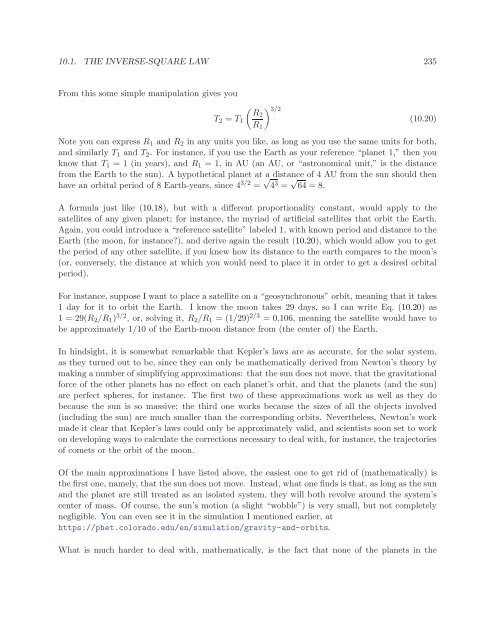University Physics I - Classical Mechanics, 2019
University Physics I - Classical Mechanics, 2019
University Physics I - Classical Mechanics, 2019
Create successful ePaper yourself
Turn your PDF publications into a flip-book with our unique Google optimized e-Paper software.
10.1. THE INVERSE-SQUARE LAW 235<br />
From this some simple manipulation gives you<br />
( ) 3/2 R2<br />
T 2 = T 1 (10.20)<br />
R 1<br />
Note you can express R 1 and R 2 in any units you like, as long as you use the same units for both,<br />
and similarly T 1 and T 2 . For instance, if you use the Earth as your reference “planet 1,” then you<br />
know that T 1 = 1 (in years), and R 1 = 1, in AU (an AU, or “astronomical unit,” is the distance<br />
from the Earth to the sun). A hypothetical planet at a distance of 4 AU from the sun should then<br />
have an orbital period of 8 Earth-years, since 4 3/2 = √ 4 3 = √ 64 = 8.<br />
A formula just like (10.18), but with a different proportionality constant, would apply to the<br />
satellites of any given planet; for instance, the myriad of artificial satellites that orbit the Earth.<br />
Again, you could introduce a “reference satellite” labeled 1, with known period and distance to the<br />
Earth (the moon, for instance?), and derive again the result (10.20), which would allow you to get<br />
the period of any other satellite, if you knew how its distance to the earth compares to the moon’s<br />
(or, conversely, the distance at which you would need to place it in order to get a desired orbital<br />
period).<br />
For instance, suppose I want to place a satellite on a “geosynchronous” orbit, meaning that it takes<br />
1 day for it to orbit the Earth. I know the moon takes 29 days, so I can write Eq. (10.20) as<br />
1 = 29(R 2 /R 1 ) 3/2 , or, solving it, R 2 /R 1 =(1/29) 2/3 =0.106, meaning the satellite would have to<br />
be approximately 1/10 of the Earth-moon distance from (the center of) the Earth.<br />
In hindsight, it is somewhat remarkable that Kepler’s laws are as accurate, for the solar system,<br />
as they turned out to be, since they can only be mathematically derived from Newton’s theory by<br />
making a number of simplifying approximations: that the sun does not move, that the gravitational<br />
force of the other planets has no effect on each planet’s orbit, and that the planets (and the sun)<br />
are perfect spheres, for instance. The first two of these approximations work as well as they do<br />
because the sun is so massive; the third one works because the sizes of all the objects involved<br />
(including the sun) are much smaller than the corresponding orbits. Nevertheless, Newton’s work<br />
made it clear that Kepler’s laws could only be approximately valid, and scientists soon set to work<br />
on developing ways to calculate the corrections necessary to deal with, for instance, the trajectories<br />
of comets or the orbit of the moon.<br />
Of the main approximations I have listed above, the easiest one to get rid of (mathematically) is<br />
the first one, namely, that the sun does not move. Instead, what one finds is that, as long as the sun<br />
and the planet are still treated as an isolated system, they will both revolve around the system’s<br />
center of mass. Of course, the sun’s motion (a slight “wobble”) is very small, but not completely<br />
negligible. You can even see it in the simulation I mentioned earlier, at<br />
https://phet.colorado.edu/en/simulation/gravity-and-orbits.<br />
What is much harder to deal with, mathematically, is the fact that none of the planets in the


















